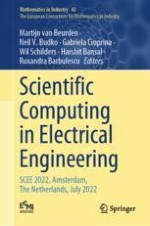This volume comprises selected papers presented at the 14th International Conference on Scientific Computing in Electrical Engineering, SCEE 2022, held in Amsterdam, The Netherlands, in July 2022.
The aim of the SCEE 2022 conference was to bring together scientists – mathematicians, electrical engineers, computer scientists, and physicists, from universities and industry – to have in-depth discussions of the latest scientific results in Computational Science and Engineering relevant to Electrical Engineering and to stimulate and inspire active participation of young researchers.
This extensive reference work is divided into four parts: Part I Circuit Simulation and Design.- Part II Device Simulation.- Part III Computational Electromagnetics.- Part IV Mathematical and Computational Methods. Each part starts with a general introduction, followed by the respective contributions.
The book will appeal to mathematicians and electrical engineers. Further, it introduces algorithm and program developers to recent advances in the other fields, while industry experts will be introduced to new programming tools and mathematical methods.
